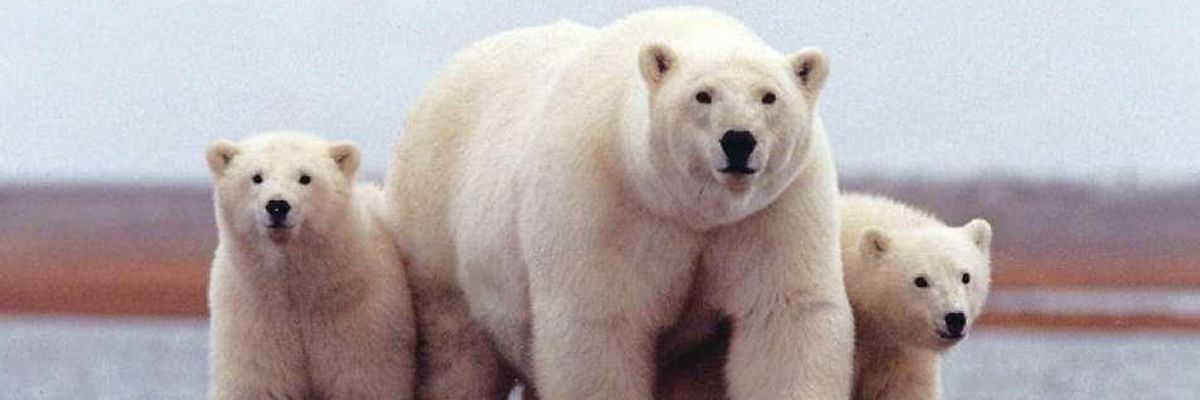Apparently the U.S. Congress thought it was okay to break treaty obligations when they passed a rider that mandated two oil and gas lease sales in the Arctic National Wildlife Refuge. Under the 2017 Tax Cuts and Jobs Act, the Biden administration is being forced to hold a second lease sale this year.
This plot to industrialize the Arctic refuge threatens a population of 500 polar bears that wander along the Beaufort Sea shore and den on the coastal plain of our largest and wildest refuge. While they can’t speak to Congress, they certainly have rights and laws that should protect them.
In January, pregnant polar bears are curled up in dens that they have dug out in snowdrifts. Soon they will give birth to one or two cubs in the dark, icy cold of winter. The newborn bears are about the size of a guinea pig and weigh only a pound. They are helpless and dependent on their mothers who nurse them for about three months in the den. Sensitive to noise and disturbance, polar bear mothers will abandon their cubs if startled by industrial noises that are associated with seismic trains and drilling rigs. The cubs will not survive if their mothers leave the den.
Polar bears have the right to survive.
Since 2008, the Southern Beaufort Sea population of threatened polar bears has been protected under the Endangered Species Act (ESA). Over the past two decades their population has decreased by 40% because of the continued loss of sea ice habitat that they need for survival. More and more bears are denning on land because of the unstable nature of ocean ice or absence of it. Polar bears might be the largest land carnivore, but they are also a victim of climate change, showing us the catastrophic effects of our emissions each and every day they try to survive on vanishing ice floes.
In 1973 five Arctic nations signed the Agreement on the Conservation of Polar Bears to ensure that polar bear populations remained strong and healthy. One of the provisions of this multilateral treaty is that all nations will protect critical denning habitat for polar bears. Never before has the North Slope of Alaska been more critical for denning habitat than it is now. The United States needs to honor this polar bear treaty and protect the coastal plain of the Arctic refuge, not turn it into an oil field. After all, it’s a refuge, and these bears are in serious long-term danger of extinction.
When the Arctic refuge was established in 1980, the purposes were clear: to conserve fish and wildlife populations and habitats in their natural diversity including, but not limited to, the Porcupine caribou herd, polar bears, grizzly bears, muskox, Dall sheep, wolves, wolverines, and an array of migratory birds. A second purpose requires that the Secretary of Interior fulfill international treaty obligations of the United States with respect to fish and wildlife, including polar bears, and their habitats. The opportunity for continued subsistence uses by residents is to be provided, along with ensuring water quality and quantity.
Secretary Deb Haaland and the Biden administration have a duty to honor the original purposes of the Arctic refuge, to fulfill the obligations of the polar bear treaty, and to protect Beaufort Sea polar bears under the Endangered Species Act. Polar bears are also protected under the Marine Mammal Protection Act.
With three laws and an international treaty that protect polar bears, and the fact that some of the Beaufort Sea bears den in a wildlife refuge, one would think these animals are safe. But not so—not if the 2017 Tax Act leasing mandate is unrightfully prioritized over these bedrock environmental laws and a long-standing international agreement.
On the 50th Anniversary of the Endangered Species Act, it’s time for us to speak up for these struggling bears and use the law to protect them. We should elevate their status from “threatened” to “endangered.” Polar bears are as awesome as the American condor and as magnificent as the humpback whale. They are loved by children all over the world and featured in stories and movies. Companies have used them in flashy animated ads.
Polar bears have the right to survive. Their plight is as clear as melting ice. The least we can do is protect the sensitive region where they give birth in the Arctic refuge and do everything we can to lower our global emissions.

